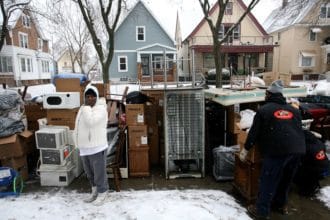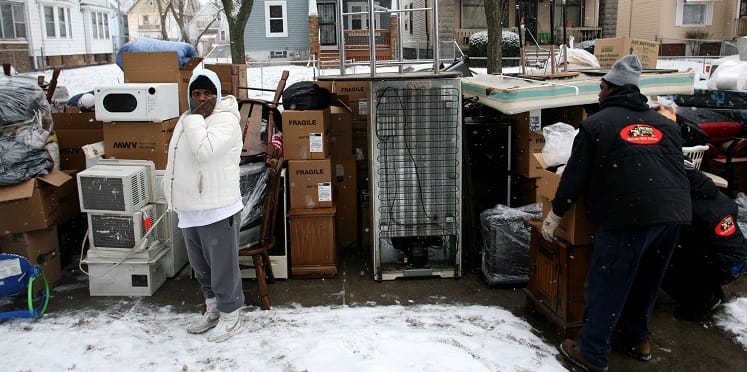“There is a knock on the door. Whether or not the belongings are packed, the kids are ready, or the new plan is put in place, no longer matters.” A few sentences written on a wall plastered with eviction notices describe what happens to a family when their landlord one day decides it has been enough; it is time to evict. Their belongings are moved to either a storage space or the curb. And because a storage unit costs money, money that evicted tenants do not have, they often choose the latter. “The movers would pile everything onto the sidewalk: mattresses; a floor-model television; a nice glass dining-table and a lace tablecloth; the meat in the freezer.”

Photo by Sally Ryan, www.sallyryanphoto.com
Each year more than 2.3 million Americans, most of them low-income renters, face eviction. The National Building Museum in Washington D.C. is now showing a collaborative exhibition with Princeton sociologist Matthew Desmond, based on his Pulitzer prize–winning book Evicted. Using photographs, videos, maps, installations and statistics, the exhibition puts faces to the names of the people who figure in Desmond’s reports about evictions in Milwaukee, and places them in the broader context of evictions and its consequences for American society. Desmond has also started a follow-up project, the website Eviction Lab (https://evictionlab.org/), which makes factual information on evictions accessible to a broad public.
The museum set it up to be an “immersive experience”. Four installations that resemble houses present the most important statistics. A large map of the United States uses different sizes of boxes to illustrate the number of evictions in each state on a yearly basis. It feels like walking through an architecture studio.

Photo by Sally Ryan, www.sallyryanphoto.com
In a video dealing with the gap between low income and ever-rising rent, Desmond speaks of an eviction epidemic in America. More than two million people receive eviction notices every year. 2.4 million were carried out in 2015, almost equivalent to the number of foreclosures at the height of the housing crisis. As a consequence, the average age of a homeless person in the United States is now nine years old.
When an eviction is issued, the case goes to court. Ninety percent of the landlords have representation, while only ten percent of the tenants do. If the tenant does not show up, the case is dubbed a default. Desmond recorded the court judgements of a few days of eviction cases. The tape sounds like a broken record: “default, default, default, default”. And ‘default’ means that the landlord can legally evict. Many tenants fail to show up, as hearings often take hours, and people cannot find a babysitter or get off work. Also, you will not be taken seriously without a lawyer, and those are too expensive.
Desmond wanted the exhibition to be free, so that the evicted could come too. And they did. Keith, an older African-American man with round glasses who works at the museum information stand, has seen homeless people from the nearby shelter come to visit. Visitors left their comments in the guestbook. Some sympathetic: “I am here because my sister was evicted.” Some seem to feel guilty: “My parents are landlords, and I hope I can change their practices.” Landlords come too, but Keith says they complain about the representation of their profession.

Photo by Sally Ryan, www.sallyryanphoto.com
And how about Washington D.C. itself? The capital claims to be legally “tenant-friendly”, and it is – compared to cities without any legislation on the issue. But Washington is not low-income tenant-friendly. More than 40,000 households are on a waiting list for public housing that has now been closed for several years. The city is growing increasingly more expensive, and it is gentrifying. Keith: “The government is the main employer. Roughly 70 percent of the people living in Washington are employed by the government. They are paid minimum wage, at least. How can it still happen here?”
The ‘Evicted’ exhibition in the National Building Museum runs through May 19, 2019: https://www.nbm.org/exhibition/evicted/ This is the sixth blog in our seven-part series ‘Poverty and Profit in the American City’. The last blog will be an interview by Katherine Oktober Matthews with Matthew Desmond himself.

